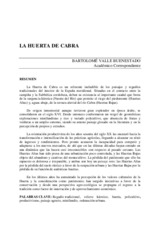| dc.contributor.author | Valle Buenestado, Bartolomé | |
| dc.date.accessioned | 2016-04-20T11:53:03Z | |
| dc.date.available | 2016-04-20T11:53:03Z | |
| dc.date.issued | 2014 | |
| dc.identifier.uri | http://hdl.handle.net/10396/13443 | |
| dc.description.abstract | La Huerta de Cabra es un referente ineludible de los paisajes y regadíos
tradicionales del interior de la España meridional. Situadas en el contacto entre la
campiña y la Subbética cordobesa, deben su existencia al importante caudal que brota
de la surgencia kárstica (Fuente del Río) que permite el riego del piedemonte (Huertas
Altas) y, aguas abajo, de la terraza aluvial del río Cabra (Huertas Bajas).
De origen inmemorial aunque tuvieron gran esplendor en época árabe, se
consolidaron en el siglo XVI. Desde entonces conformaron un vergel de geométricas
explotaciones minifundistas y rico y variado policultivo, que abastecía de frutas y
verduras a un amplio entorno, siendo su ameno paisaje glosado en la literatura y en la
percepción de propios y extraños.
La orientación productivista de los años sesenta del siglo XX las encauzó hacia la
transformación e intensificación de las prácticas agrícolas, llegando a alcanzar su zénit
de ingresos y rendimientos. Pero pronto acusaron la incapacidad para competir y
adaptarse a los nuevos mercados, de ahí que en las últimas décadas hayan entrado en
una dinámica que las hacen casi irreconocibles con respecto al pasado cercano. Las
Huertas Altas han sido presa de una urbanización poco controlada, y las Huertas Bajas
objeto del abandono y cautivas del monocultivo. La pérdida del patrimonio que ello ha
supuesto es dolorosa e irreparable, y ambas son hoy un paisaje roto: las Huertas Altas
por la pérdida del suelo rústico a favor de la ocupación urbana y las Huertas Bajas por la
pérdida de su función de auténticas huertas.
En los últimos años ha aumentado la percepción de los valores culturales de la
Huerta y la consideración como patrimonio; han surgido iniciativas a favor de la
conservación y desde una perspectiva agro-ecológica se propugna el regreso a la
tradición como factor de innovación y de aprovechamiento económico. | es_ES |
| dc.description.abstract | Inland in southern Spain, there is no better example of traditional irrigation and
landscapes than Cabra’s market gardens. Standing on the strip where the Subbetica
range and flatlands merge, they owe their existence to the flow of water from the
emergence of Karst aquifers (Fuente del Rio), that provide irrigation for the Higher
Gardens in the foothills (Huertas Altas) and downstream, for the Lower Gardens on the
river Cabra’s fluvial terrace (Huertas Bajas).
With age-old origins, they enjoyed great splendour in Arab times, but were really
consolidated in the XX century. Since then they have displayed a geometrical landscape
chequered by smallholdings with rich and varied mixed farming, supplying fruit and
vegetables to the wide area surrounding this pleasant countryside, reflected in literature
and perceived by all and sundry.
The twentieth century’s urge for productivity led them to convert and intensify
agricultural practice in the sixties, reaching maximum heights of yield and income. But
they soon fell victims of their inability to compete with and adapt to new markets,
leading them to descend in recent decades to the kind of activity that seems
inconceivable in view of their fairly recent past. The Higher Gardens have been prey to
building with no urban regulation, and the Lower Gardens subject to abandon and
victims of monoculture. The resulting patrimonial loss is at the same time distressing
and irreparable, giving rise to today’s broken landscape: the Higher Gardens through
the loss of arable land in favour of urban development and the Lower Gardens through
the disappearance of their working as proper smallholdings.
In recent years, the awareness of cultural values of market gardens and its
considerations as heritage have increased. There have been initiatives for conservation
and from an agro-ecological perspective the return to tradition as a factor of innovation
and economic use is advocated. | es_ES |
| dc.format.mimetype | application/pdf | es_ES |
| dc.language.iso | spa | es_ES |
| dc.publisher | Real Academia de Córdoba de Ciencias, Bellas Letras y Nobles Artes | es_ES |
| dc.rights | https://creativecommons.org/licenses/by-nc-nd/4.0/ | es_ES |
| dc.source | Boletín de la Real Academia de Córdoba de Ciencias, Bellas Letras y Nobles Artes 163, 245-264 (2014) | es_ES |
| dc.subject | Regadío tradicional | es_ES |
| dc.subject | Relieve kárstico | es_ES |
| dc.subject | Huerta | es_ES |
| dc.subject | Policultivo | es_ES |
| dc.subject | Productivismo | es_ES |
| dc.subject | Paisaje agrario | es_ES |
| dc.subject | Minifundio | es_ES |
| dc.subject | Ordenación urbana | es_ES |
| dc.subject | Traditional irrigation | es_ES |
| dc.subject | Karst topography | es_ES |
| dc.subject | Market garden | es_ES |
| dc.subject | Mixed farming | es_ES |
| dc.subject | Productivity | es_ES |
| dc.subject | Agricultural landscape | es_ES |
| dc.subject | Smallholding | es_ES |
| dc.subject | Urban regulation | es_ES |
| dc.title | La Huerta de Cabra | es_ES |
| dc.type | info:eu-repo/semantics/article | es_ES |
| dc.rights.accessRights | info:eu-repo/semantics/openAccess | es_ES |

